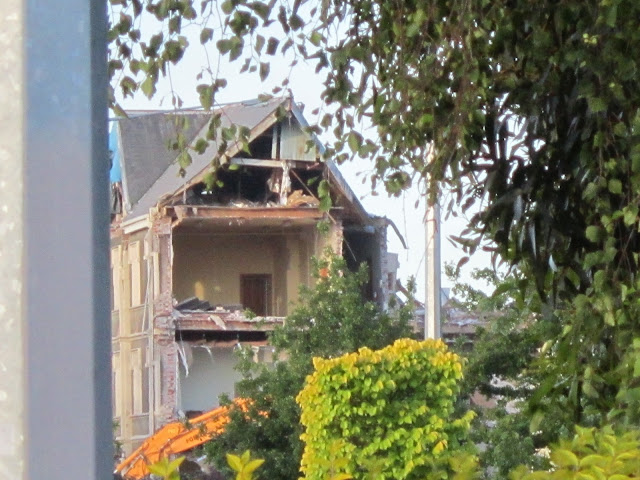Visiting Glacier Country was supposed to be the highlight of our trip to the South Island, and it certainly didn’t disappoint. There are 2,500 glaciers in New Zealand (doesn’t that sound like a lot?), but only two that are accessible to visit….and they happen to be almost right next to each other. Nestled into the Southern Alps are the Franz Josef Glacier and Fox Glacier. We had read that the Fox Glacier is a better experience on the Glacier, so our aim was to take a guided helicopter tour which drops you off on the glacier for a two hour hike. As mentioned in the last post, the weather wasn’t cooperating well, so the odds seemed slim that we could get a helicopter ride. The first two helicopter tours were cancelled on the day we were visiting. While waiting for the flight, we walked up to the face of the Fox Glacier. At the foot of the Glacier is a rainforest, complete with moss growing on trees, plenty of ferns and streams with crystal clear mountain snow runoff. Here are a few photos of the rainforest and Fox Glacier:



After the second flight of the day was canceled, we drove to the Franz Josef Glaicer. During our walk to the face of the Glacier, the weather gods finally decided to smile upon us and the sun peaked through. The hike to the Franz Josef Glacier was beautiful as it crossed through rainforest and then into a cavernous valley that leads up to the massive block of ice. Couple pictures of the Franz Josef and the surrounding valley:
If you look at the bottom of this picture, you’ll see that there is a substantial amount of water flowing out of the bottom of the glacier and it’s gray in color. All of the glacier runoff has this milky gray look to it due to the combination of glacier particles along with the melting ice.
With our hopes lifted by the sun, we returned to the Fox Glacier (they are about 20 km apart) and the weather had improved enough that the guiding company was going to get the helicopter up in the air. Dana and I have taken two helicopter rides together before, one at the Grand Canyon and one at Volcano National Park in Hawaii. Both were amazing experiences that let you get a whole new appreciation for the dramatic scenery. This helicopter ride was better than both of them. Maybe it’s due to restrictions in the US, but those helicopter rides were tame compared to the aggressive dives that our Kiwi pilot took us on. At times it certainly felt like we were flying more vertical than horizontal and it provided an amazing sweeping view of the entire glacier. All the G forces turned out to be a little much for one Australian who was left feeling light headed after the ride. Dana got a front seat view with the pilot and took the opportunity to get some great photos:





This is Victoria Falls that is mountain runoff that plummets right into the glacier in these last three. The helicopter got us a great view and the drop off below what you can see here is hundreds of feet.
The helicopter left us and we hiked around on the glacier with our guides from Nepal and Iceland. The huge scope of the glacier and the surrounding mountains makes you feel small and insignificant. There were some amazing blue colors that were created from the ice. We drank glacier water, which apparently isn’t as ‘nutritious’ as spring water because it lacks some minerals…..however it tasted great. We spent around a hour and a half exploring the glacier:




We still had about an hour to go on the exploration, however with dark clouds forming in the valley, the helicopter team radioed that the conditions were deteriorating and we should head back early. At this point the guides rounded the group up and led us back to the makeshift helicopter landing pad (which was on ice, and just had some rocks to outline the flat area). We waited at the landing pad listening to the dispatchers below comment on how dark the clouds were and how the helicopters were trying to go through, but didn’t have enough visibility. At first there was some good natured laughing among the group and guides as to how we would cope up on the glacier for the night. After about a half hour or so, the possibility of us spending the night on the glacier seemed to get more real as it started to rain and the clouds were a dark dark grey. There was precedence for this as two guided groups had previously spent the night on the glacier. We didn’t become the third. Thankfully they brought in a second helicopter pilot who bravely found a sliver of visibility and made it to pick us up. Here is what the mountains looked like with helicopter coming back.


Amazing trip and lucky to have that sliver of good weather to get in a full glacier experience.



















































